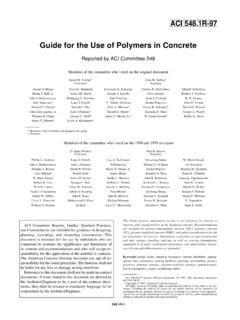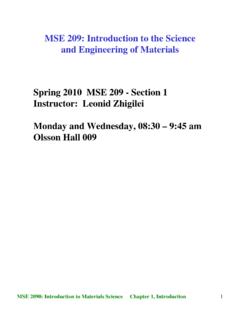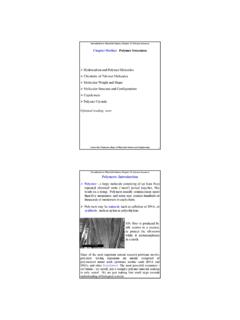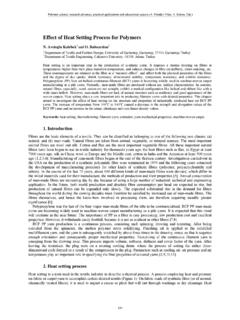Transcription of STRUCTURE AND FUNCTION OF BIO- MOLECULES
1 STRUCTURE and FUNCTION of biomolecules - 8 - STRUCTURE AND FUNCTION OF BIO- MOLECULES Table of contents 1. Introduction 9 2. Proteins 13 o The Amino Acids o The Peptide bond o The Protein Conformation o The secondary structures: -helix and -sheet 3. Lipids 25 o Fatty Acids o Hormones derived from Fatty Acids o Neutral Fats (complex lipids) o Other complex lipids o Micelles lipid double layers o Simple Lipids 4. Carbohydrates (saccharides) 32 o Monosaccharides o The glycosidic bond o Disaccharides and polysaccharides (Glycanes) o Glycoaminoglycans o Glycoproteins 5.
2 Polynucleotides 42 o Polynucleotides o Ribozymes o The DNA/RNA molecule o The genetic code o Flow of the genetic information 6. R sum 51 7. Probl mes 60 STRUCTURE and FUNCTION of biomolecules - 9 - 1. INTRODUCTION The MOLECULES that form the building blocks of living organisms obey the same laws of nature as all other chemical MOLECULES . However, such MOLECULES are different in a sense that they have a FUNCTION . They can be seen as highly efficient tools and/or machines or as dedicated building materials . Certain biomolecules even have the ability to replicate and repair themselves.
3 As far as we know there are no biomolecules without FUNCTION . However, in a number of cases this FUNCTION is not known. Many biological MOLECULES form complex and highly ordered structures. This order is maintained using energy from the surrounding. The chemistry of such MOLECULES is nevertheless an important basis for understanding how biomolecules can fulfill their diverse functions . All biologi-cal phenomena have a molecular and therefore a chemical basis (Table ). Table Distribution of the most important ele-ments Earth (crust) Human body O % Si % Al % Fe % Ca % Na % K % Mg % Ti % H % C % H % O % C % N 5 Ca % P % Cl
4 5 K 5 S % Na % Mg % Major elements of the organic materials: O, C, N, H, P, S Elements that form stable covalent bonds Elements from the middle of the PSE medium strength electronegativity STRUCTURE and FUNCTION of biomolecules - 10 - little tendency to form ions Elements from the top of the groups double bonds possible light atoms, strong bonds Carbon atoms can link to each other and form 3D structures Ions: Na+, K+, Mg2+, Ca2+, Cl- Trace elements: Mn, Fe, Co, Cu, Zn, B, Al, V, Mo, I, Si, Sn, Ni, Cr, F, Se The number of biological MOLECULES is extremely large.
5 However, the number of building blocks used to make these MOLECULES is surprisingly small (Table ). The MOLECULES tend to have similar FUNCTION in all living organisms. Especially the higher organisms tend to use building blocks de-rived from food to build their own macromolecules (metabolism). Table Examples of building blocks used in biological MOLECULES . Components of the nucleic acids Some components of lipids COHHCH2 OHCH2 OHglycerol STRUCTURE and FUNCTION of biomolecules - 11 - A monosaccharide STRUCTURE and FUNCTION of biomolecules - 12 - Table Typical Biopolymers Monomers Polymers AMINO ACIDS (Lysine) Proteins Peptide Hormones Neurotransmitters Toxic alkaloids NUCLEOTIDES (Adenin) Nucleic Acids ATP Coenzymes Neurotransmitters FATTY ACIDS (Palmitic acid) Membrane lipids Fats Waxes SUGARS (Glucose)
6 Cellulose Starch Fructose Mannose Sucrose Lactose The building blocks are used to form typical biopolymers such as proteins (amino acids), polysac-charides (monosaccharides), DNA/RNA (mononucleotides), and lipids (molecular aggregates) (Ta-ble ). The FUNCTION of these biopolymers tends to be the same in all living organisms. In addition, the basic building blocks can be modified to fulfill other functions . For example, 20 amino acids are used to build the proteins. Besides those more than 150 amino acids are known, which fulfill other functions in the living organism. Most of these are chemical descendents of the 20 basic ones. Hy-brid-biopolymers are also known. Examples are the glycoproteins, which contain either one or sev-eral polypeptide chains (amino acids) and one or several glycosilation structures (saccharides).
7 STRUCTURE and FUNCTION of biomolecules - 13 - Tasks / functions of biopolymers Polynucleotides Storage and transfer of genetic information Proteins Realization of the genetic information, catalytic and transport functions , build-ing material, etc. (many others) Polysaccharides Storage of energy, structures (building material for the cell walls, etc.) Lipids Storage of energy, structures (building material for cell membranes, etc.) Only polynucleotides and proteins store information in their STRUCTURE . STRUCTURE and FUNCTION of biomolecules - 14 - 2. PROTEINS To a large extent, cells are made of protein, which constitutes more than half of their dry weight (Table ).
8 Proteins are the most versatile class of MOLECULES in living organisms. Amongst their functions are: catalysis (enzymes), transport, storage (casein), contraction (muscles), protection (antibodies), attack (toxins), hormones (insulin, growth hormone) and STRUCTURE (collagen). All pro-teins contain C, H, N, O some S, P, Fe, Zn, Cu. Acidic hydrolysis yields 20 different -amino acids (L-form), which are encoded by the genetic code and which constitute the building blocks of the proteins in all living organisms. In addition, approximately 150 amino acids are known, which are not encoded by the genetic code and which are sometimes posttranslatorial modifications of the above mentioned 20 -amino acids.
9 However, and -amino acids are also known as well as some D-type amino acids. Typical posttranslatorial modifications of amino acids in proteins include: ace-tylation of the N-terminus (reduces degradation), hydroxylation of proline residues transformation of glutamate into -carboxyglutamate or the addition of sugar residues and lipid MOLECULES to mod-ify the final hydrophobicity of the molecule. Phosphorylation and methylation of specific amino acid residues have a signaling effect in several metabolic pathways. These modifications generally are reversible. Many proteins are also cleaved and trimmed after synthesis (trypsinogen trypsin). Table Approximate Chemical Compositions of a Typical Bacterium and a Typical Mammalian Cell Percent of Total Cell Weight Component E.
10 Coli Bacterium Mammalian Cell H2O 70 70 Inorganic ions (Na+, K+, Mg2+, Ca2+, Cl-, etc.) 1 1 Miscellaneous small metabolites 3 3 Proteins 15 18 RNA 6 DNA






